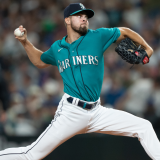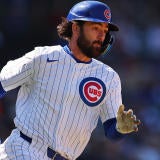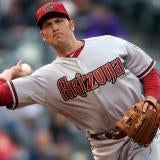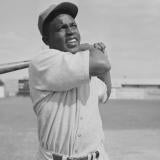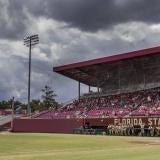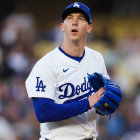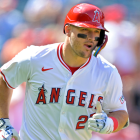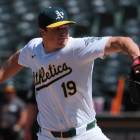 |
| Dustin Pedroia and David Ortiz are important parts of the Boston core. (Getty Images/EOB) |
Our "Core Values" series soldiers on with an examination of the Boston Red Sox, the team that followed up a colossally disappointing 2011 with an epically disappointing 2012.
As for what actually defines a "core" in our unscientific series, here's a refresher. Feel free to skip over the blockquotes if you've been with us since the start.
What's a core? For our purposes, a team's core comprises a "cornerstone player," a "face of the franchise" and then the "future face of the franchise."
So what's a "cornerstone player"? For starters, it's one of the best players on the roster and perhaps the very best player on the roster. Beyond that, though, it's the player whom the organization has identified as the talent around which to build by signing him to a long-term deal. In other words, they've backed their faith in the player's abilities with the most powerful statement of all: lots of redeemable U.S. currency. Not only do they see this player as central to their current aims but also to their designs on future contention.
What's a "face of the franchise"? He -- and we're getting subjective here -- is the player who most prominently embodies the franchise in question. He's that player whom you think about when you think about this team. Is he the same guy as the "cornerstone"? Sometimes. But the cornerstone is primarily a financial designation. The "face" is, for lack of a better term, a cultural identifier. They're not mutually exclusive, but they're not not mutually exclusive, either. What about the word "values" that you see in the headline above? After we identify and evaluate the three elements of the core, we're going to slap a letter grade on the whole thing.
And now to the core of the Red Sox.
Cornerstone player(s): John Lackey
Well, if that isn't a frightening thought. But, yes, Lackey is at present Boston's signature financial commitment (recall this category is all about contracts).
The terminally scowling right-hander inked a five-year, $82.5 million in December of 2009. The deal raised a few eyebrows at the time, but then Lackey went out an authored a 5.26 ERA over the first two seasons of the pact. And then he tore elbow ligaments and underwent Tommy John surgery, which caused him to miss the entire 2012 season. The only upside for Boston is that Lackey's elbow injury kicked in a team option for 2015, in which the Sox can secure Lackey's services for the league-minimum salary. It's possible Lackey will be a useful member of the rotation over the remainder of the deal, but he's been a boondoggle thus far.
The Sox also have three other players locked up through 2015: Dustin Pedroia (all good, and more on him in a moment), Shane Victorino (a highly dubious decision) and Clay Buchholz (a potentially dubious decision). What becomes of Jacoby Ellsbury, who's eligible for free agency after the upcoming season, is a situation to monitor.
Face(s) of the franchise: David Ortiz and Dustin Pedroia
Give it to the two warhorses. Ortiz, of course, has been with the team since 2003, and he presently has the fifth-most home runs in franchise history (343 in the Boston uniform). Ortiz turned 37 this offseason, but he's still capable of playing at a high level when healthy. Indeed, Ortiz last season batted .318/.415/.611 before an Achilles strain laid him up for good. There's no doubting what he can still do at the plate. However, he's a DH in his late 30s. The proneness to injury is only going to increase, and deep statistical decline could set in at any moment.
As for Pedroia, the 29-year-old second baseman is coming off a season in which he put up an OPS+ of 112, smacked 39 doubles and stole 20 bags. That marks a decline from his 2010-11 levels, but throw in Pedroia's still-excellent defense and you've got a player who's very much an asset even when his plate production is "merely" good instead of great.
Face(s) of the future: Xander Bogaerts and Will Middlebrooks
The 20-year-old Bogaerts, who was signed out of Aruba in 2009, set High-A and Double-A afire last season despite being much younger than his peer group. At the plate, his ceiling is as high as any prospect's in baseball -- he's got power to spare and the chops to hit for high averages. If Bogaerts adapts to breaking and off-speed stuff at the highest level, he's going to be a special player. Weaknesses? More on that in a moment.
Middlebrooks, meanwhile, batted .288/.325/.509 last season with 15 home runs in 75 games. Needless to say, he was on his way to a very impressive rookie campaign until a wrist fracture ended his season. The 24-year-old isn't going to be much of an on-base guy, but he projects to have 25-home run power one day, and his glove at third is an asset. He'll be a quality performer, both at the plate and in the field, for years to come.
One concern is that Bogaerts, because of his limited range, might eventually be moved off shortstop. Third base, which of course is Middlebrooks's position, would be the natural landing spot, but Middlebrooks is the better fit. Bogaerts figures to have the bat to play anywhere on the diamond, but if he's, say, a first baseman then his productivity bar will be that much higher. There are, of course, worse problems to have.
Grading the Red Sox's core: D
There's talent here and the potential for a winning season. But when a large part of your core consists of a DH in his late 30s and a pitcher who was a disappointment even before shredding his UCL, the news isn't good. So it is with Boston.
For more baseball news, rumors and analysis, follow @EyeOnBaseball on Twitter, subscribe to the RSS feed and "like" us on Facebook. Also, individually interact with us on Twitter: @MattSnyder27, @daynperry and @mikeaxisa.







